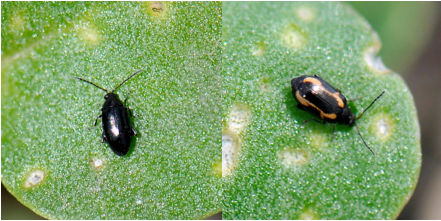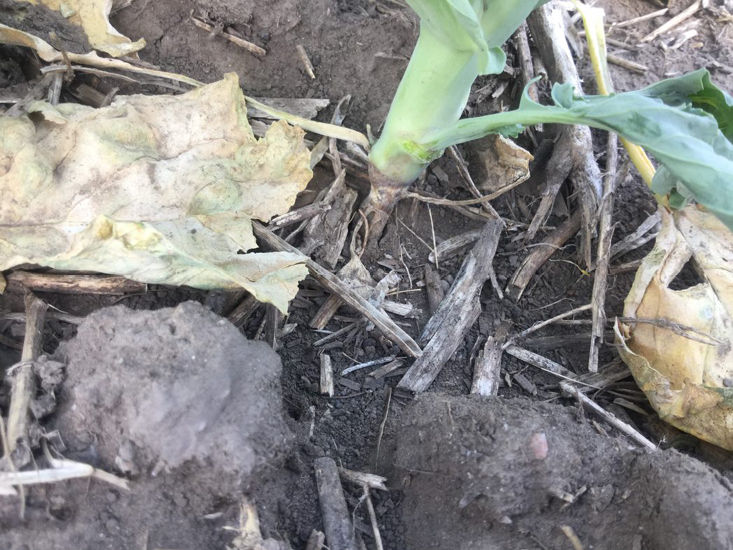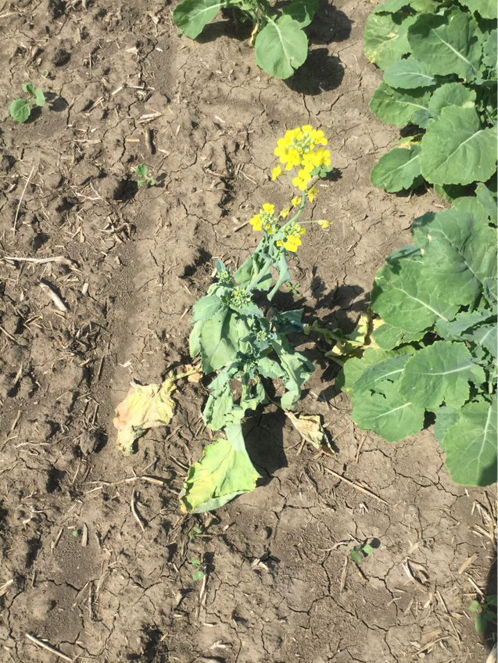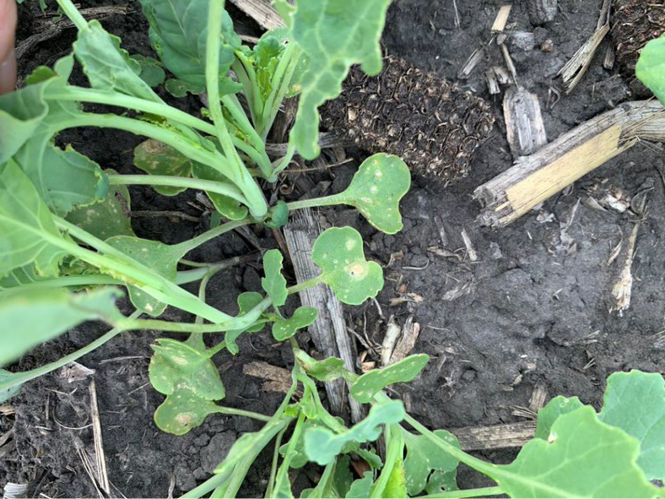Early-Season Pest in Canola
November 3, 2022
Early-season pests include insects and plant diseases. The major insect pests are flea beetles and cutworms. The major seedling diseases include Pythium and Fusarium species and Rhizoctonia solani.
Flea beetles
Based on grower surveys, flea beetles are the number one concern of western Canadian canola farmers.1 The flea beetle complex attacking canola, rapeseed, and mustard consists of the crucifer flea beetle and striped flea beetle, with the primary species being the crucifer flea beetle (Figure 1). Currently, both species are widespread across the United States and Canada. The adults are small, about 1/16 inch in length and can “hop” with the use of an enlarged hind femur, when disturbed (Figure 1). The biology and injury the insects cause is similar

Adult flea beetles cause the primary damage when they feed on host plant cotyledons and first true leaves during two weeks after emergence, particularly during hot and dry weather. Under extreme feeding injury the growing point can be injured resulting in plant death. Feeding greater than the economic threshold can reduce plant stand, delay growth and plant maturity, and reduce yield potential.
1 See FLEA BEETLE MANAGEMENT IN SPRING CANOLA for in-depth management tactics for flea beetles attacking canola.
Cutworms2
The two major cutworm species attacking canola are the redbacked cutworm and dingy cutworm.1
The redbacked cutworm overwinters as eggs, which begin to hatch in April. Larvae begin to feed on nearby plants with most injury occurring in June. Feeding occurs at night as larvae emerge from the soil in search of plants. Injury by young larvae results in small holes and notches on the leaves. As the larvae age they attack stems and usually sever them at or just below the soil line. When scouting fields, look for patchy areas of injury that contain dead or dried plants.
The dingy cutworm is a complex of 3 species, which for practical purposes the management is the same. The dingy cutworm is a climbing cutworm, not a “cutting” cutworm like the redbacked cutworm. Dingy cutworms feed on the leaves resulting in notches or holes in the leaves. Since they overwinter as partially grown larvae, the damage in the early spring can be significant.
Scouting and Management
These two species (as well as most other cutworms) are nocturnal feeders, so daytime sampling should be focused on plant injury. Bare areas in the field, notches or holes in the leaves, wilted plants, can all be signs of cutworm injury. Generally, the bare spots will first appear on south facing slopes as the soil is warmer and cutworm activity will occur earlier than other parts of the field. Dig around injured or missing plants at a depth of 2 inches and examine the soil for cutworms. Occasionally they can be found to a depth of 4 inches so a hand trowel is often very useful. The caterpillars will assume a C-shape when held. Larvae post the greatest risk for economic damage when they are small. The action threshold (based on experience and not research) is when 25 to 30% injury has occurred and larvae are small, 0.5 to 0.7 of an inch as they still must consume plant tissue to grow. 2 Conversely, if the larvae are 1.2 to 1.4 inches, most of the feeding has occurred and there is little to be gained with the use of an insecticide.

Seedling diseases3
There are three main soilborne pathogens that can infect canola seedling: Pythium and Fusarium species and Rhizoctonia solani. Losses from these diseases tend to be highest under cold, wet conditions or when the seedbed is not firmly packed under dry, cool conditions. The disease complex is most often a problem when soil is cool and wet for prolonged periods of time. Generally, cold and damp soils are more prone to infection by Pythium species, while a loose seedbed, cold, and dry soils favor Rhizoctonia solani, and wet and heavy soil are more prone to infection by Fusarium species.
Scouting and Management
Examine areas with poor emergence. If the seeds fail to germinate and are found to be soft and spongy or if germinated, seedlings have died prior to emergence, it may be the result of one or all three of the soil-borne pathogens. In some cases, seedlings may appear normal above the soil line, but infection has occurred below ground with the pathogen moving up the hypocotyl resulting in a girdled stem. Plants may also appear wilted or off-colored (Figure 3). In infected plants that have emerged, the hypocotyl may appear shriveled, pinched, or discolored a reddish brown. Under ideal conditions these plants may survive but growth will stagnate (Figure 4). Examination of the roots will indicate missing rootlets and may indicate one or all three of the root rot pathogens.


Current seed treatments are very effective against these soil-borne pathogens. Other management tactics include extending the rotation, eliminating volunteer canola which can act as host for the pathogens, increasing the level of inoculum in the soil. Other management tactics include 1) reduce seeding depth to promote quicker emergence and lessen contact with pathogens, and 2) plant high quality seed with high germination tests, particularly in colder soils.
Blackleg4
Blackleg is a serious disease of canola across all canola growing areas. Seedling infection may occur from infected seed, or from rain splashed, and airborne spores. Plants infected at this stage usually exhibit the most severe damage. Initial infection appears as a white lesion dotted with black pycnidia anywhere on the plant (Figure 5). All growth stages of canola are susceptible to blackleg. Stem cankers, which occur most frequently if infection of plants happens before the two-leaf stage, are associated with serious yield loss.

Scouting and Management
Seed-treated certified seed can manage seed-borne blackleg infection, which will reduce the chance of new pathogen being introduced into the field. There are Brassica napus (Argentine canola) cultivars that contain some genetic resistance to the blackleg pathogen; however, the resistance is not complete. Research has found that the use of resistance cultivars in conjunction with longer rotations between canola production can reduce the incidence of blackleg. For a more detailed description and management tactics for the disease see Managing Blackleg in Canola.
Sources
1Isaacs, J. 2020. Manitoba’s top five insect pests of canola. Top Crop Manager. https://www.topcropmanager.com/manitobas-top-five-insect-pests-of-canola/
2Cutworms. 2022. Canola Encyclopedia. Canola Council of Canada. https://www.canolacouncil.org/canola-encyclopedia/insects/cutworms/
3Root rot. 2022. Canola Encyclopedia. Canola Council of Canada. https://www.canolacouncil.org/canola-encyclopedia/diseases/root-rot/
4Blackleg. 2022. Canola Encyclopedia. Canola Council of Canada https://www.canolacouncil.org/canola-encyclopedia/diseases/blackleg/
2015_14492